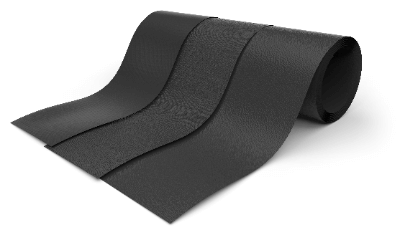What Is Sheet Rubber?

Sheet Rubber is a product made of rubber in the form of a thin plate or sheet.
Generally, thin sheets of rubber are used as sealing materials, while thicker sheets are used to absorb vibration and shock. They are also sometimes used for soundproofing and heat insulation. Since rubber materials and thicknesses exist for various applications, the most suitable one is used depending on the application such as insulation and workability.
Uses of Sheet Rubber
Sheet Rubber is used in a variety of applications due to its flexibility and high sound insulation properties. The following are examples of applications of Sheet Rubber:
1. Parts
Sheet Rubber may be used as parts for industrial products. In the automotive industry, they are used for engine mounts and door glass sealing materials. It is also used in building material parts, and is utilized as blade base parts and oil seals.
In the field of medical equipment, Sheet Rubber is commonly used for molding various products due to its stable properties. Examples of such products include sealing materials and catheters. Its excellent electrical insulation properties make it a suitable material for use in electrical products, like computer keypads.
2. Soundproofing Materials
Sheet Rubber is also used as a soundproofing material because of its high soundproofing brain. They are used as sound-absorbing materials stretched on walls and ceilings, and in speaker boxes. Another feature of rubber sheets is that they are easy to apply and can be retrofitted.
3. Work Mats
Sheet Rubber is inexpensive, and as a result, it is occasionally used as work mats. Due to its electrical insulation properties, it is also utilized as insulating mats for workers during electrical withstand voltage tests. They are also used as curing mats to prevent scratches.
Because it is soft and non-slip, it is excellent as a floor mat.
Principle of Sheet Rubber
The principle of Sheet Rubber is based on the phenomenon of elastic deformation. Due to the high elasticity of rubber, it deforms when subjected to external force, but returns to its original shape when the force is removed. This elastic deformation makes Sheet Rubber flexible and durable.
The principle behind the elastic deformation of Sheet Rubber is that the long chains of rubber molecules have a unique three-dimensional structure. This three-dimensional structure makes the rubber molecules elastic and stretchable.
In addition, rubber molecules are polymerized and have a large molecular weight. Therefore, it is difficult for them to move in space, and when they are subjected to external force, the internal intermolecular interactions work to deform the entire rubber, resulting in elastic deformation.
Taking advantage of these properties of rubber, Sheet Rubber is used in a wide variety of applications.
Types of Sheet Rubber
There are various types of Sheet Rubber depending on the type of rubber used as the material. The following are examples of Sheet Rubber:
1. Natural Sheet Rubber
Sheet Rubber made of natural rubber, which is standardized by JIS as “cis-1,4-polypropylene obtained from the paracomplex tree”. It is characterized by high elasticity and durability.
The main production areas of natural rubber are the tropical regions of Southeast Asia, Africa, and Central and South America, where the Para rubber tree grows. Of these, production in Southeast Asia accounts for about 80% of total production. It is mainly used for tires and sealing materials.
2. Silicon Sheet Rubber
This Sheet Rubber is resistant to high and low temperatures and has high weather and chemical resistance. It is used in medical equipment, food machinery, electrical products, etc. It is used in food packaging, etc. due to its resistance to heat and cooling.
3. Urethane Sheet Rubber
This Sheet Rubber uses urethane rubber, a polymer with urethane bonds. It has the advantage of long-term use due to its superior mechanical strength and abrasion resistance. It is used for soles of sports shoes.
4. Fluorine Sheet Rubber
This Sheet Rubber has very high heat resistance and chemical resistance. It is used for semiconductor manufacturing equipment and high-purity gas piping.
5. Nitrile Sheet Rubber
This Sheet Rubber is made of nitrile rubber, a copolymer of acrylonitrile and butadiene. Oil resistance and cold resistance can be changed by changing the composition of acrylonitrile and butadiene. High nitrile has high oil resistance and low nitrile has excellent cold resistance.
It is used in petrochemical products and automobile parts. Hydrogenated nitrile rubber sheet, partially hydrogenated to improve ozone and weather resistance, is also commercialized.
6. Ethylene-Propylene Sheet Rubber
This Sheet Rubber is made of ethylene propylene, a random copolymer of ethylene and propylene. EPM has no unsaturated bonds in the main chain and cannot be vulcanized by sulfur. On the other hand, ethylene propylene diene rubber copolymerized with a small amount of monomer having unsaturated bonds to enable sulfur vulcanization is called EPDM.
EPDM has high resistance to weather and aging and is used in outdoor equipment and rainwater treatment facilities.